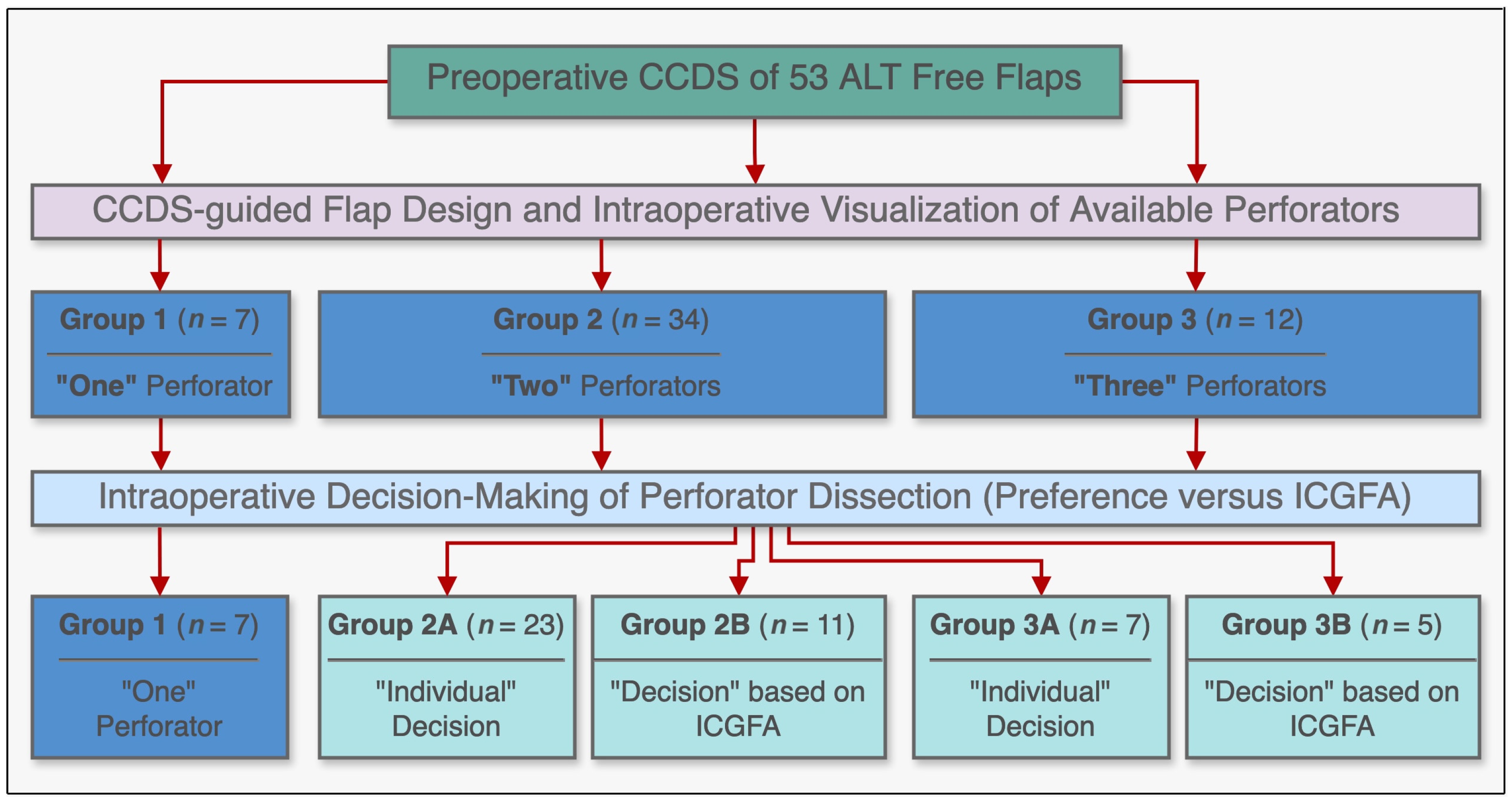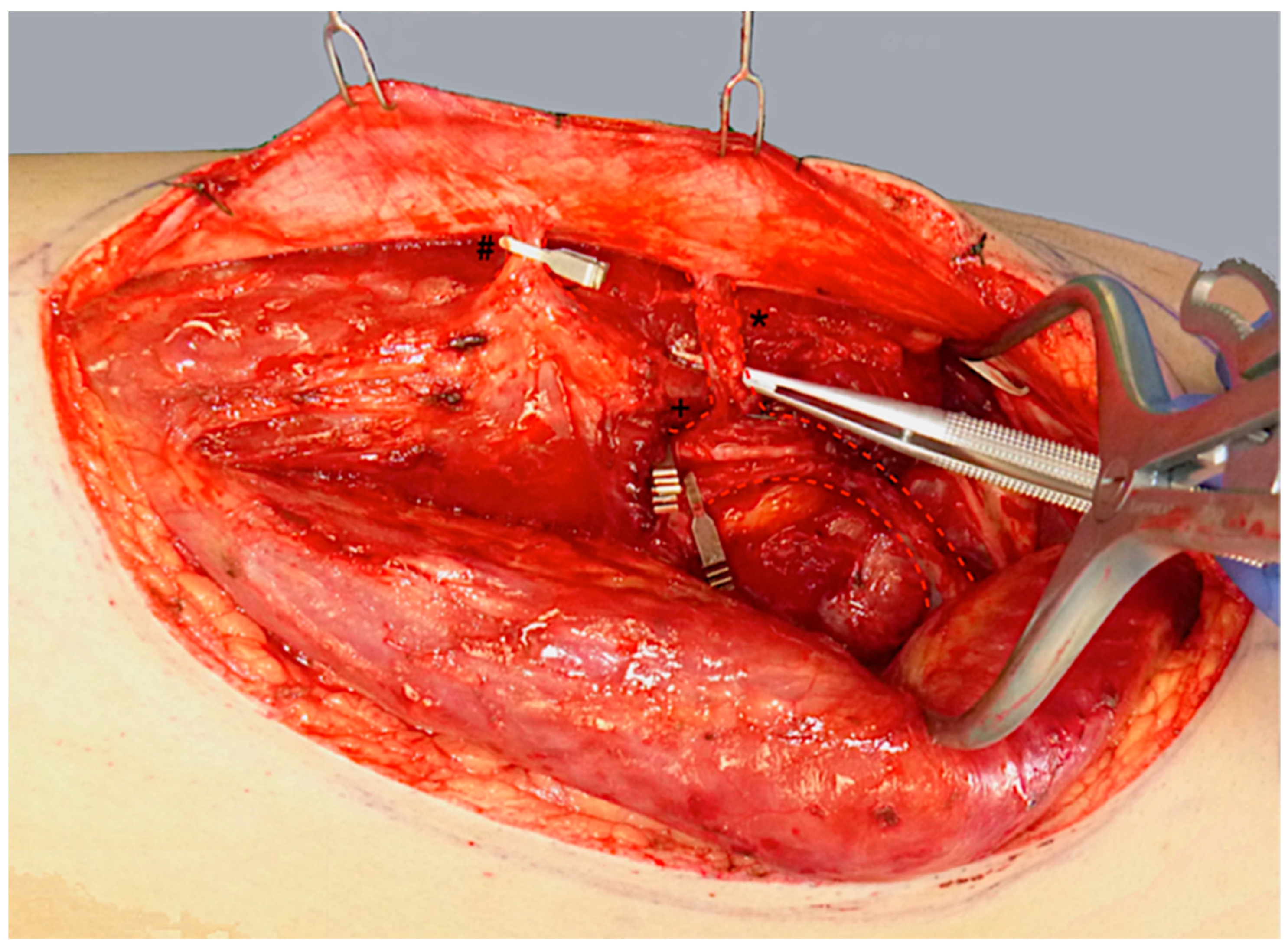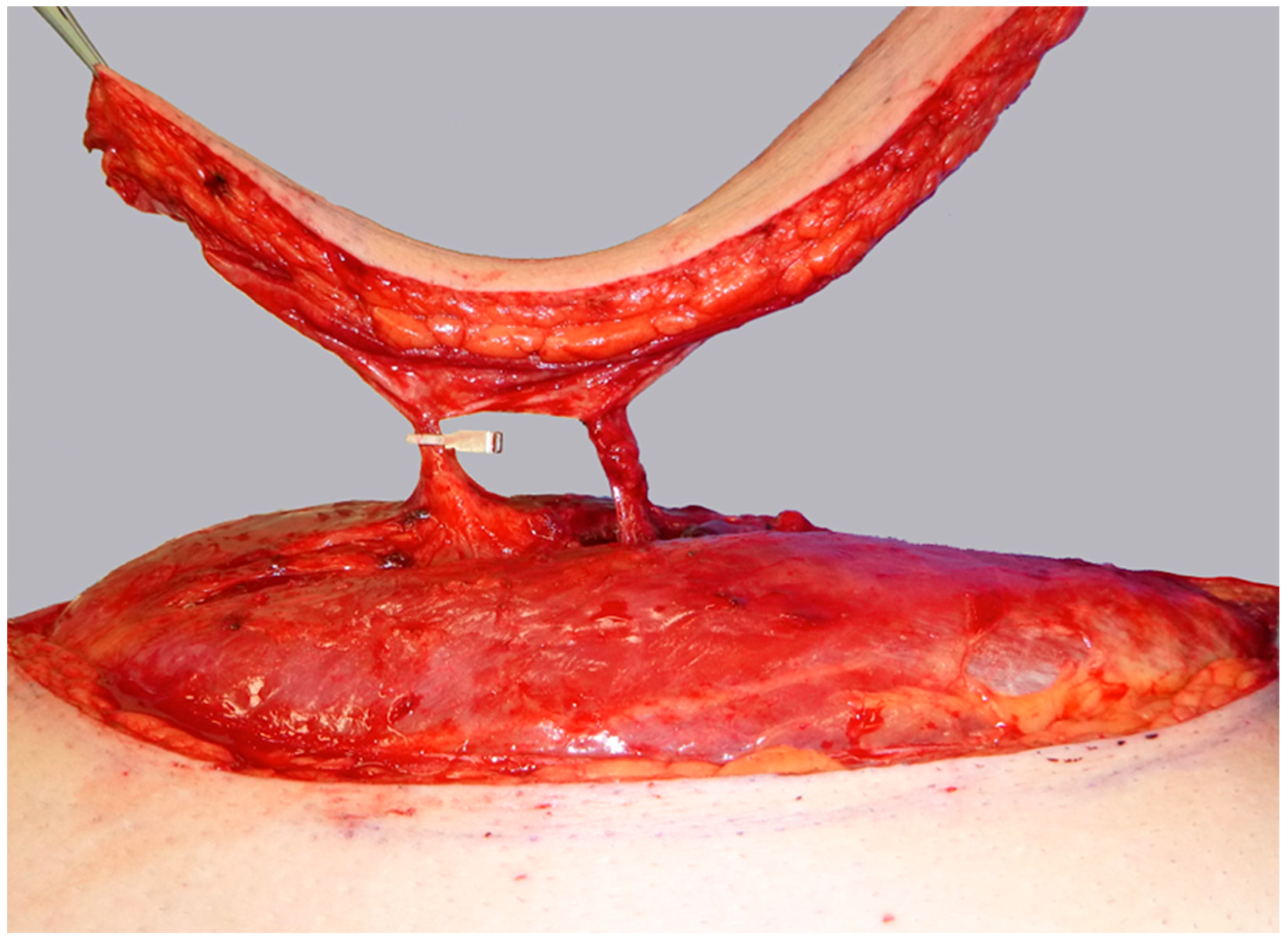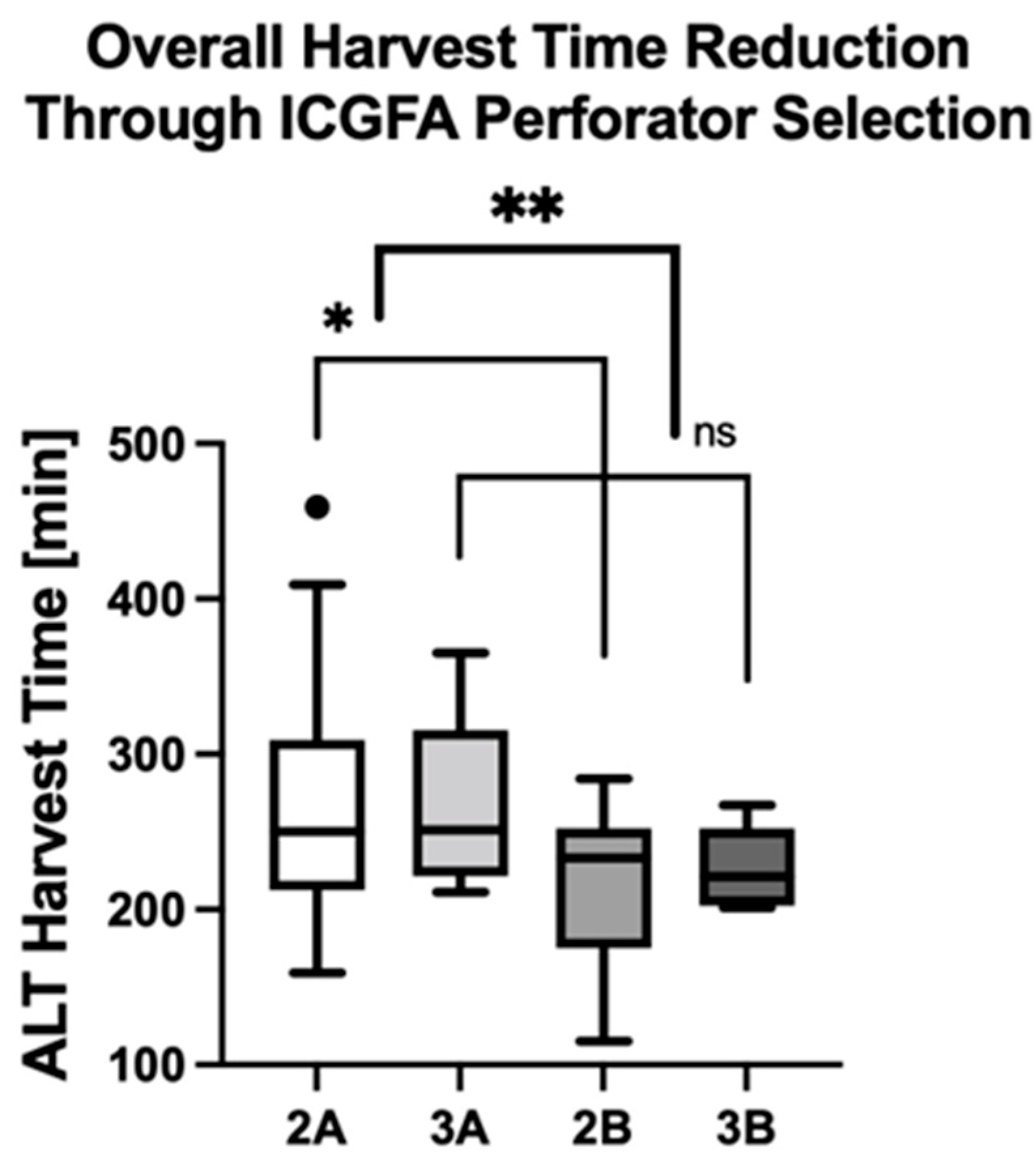Optimizing ALT Flap Harvest: The Role of Combined Preoperative Duplex Ultrasound and Intraoperative ICG Angiography for Perforator Selection
Abstract
1. Introduction
2. Materials and Methods
2.1. Patients
2.2. Study Design and Setting
2.3. Methods
2.4. Operative Technique of ICGFA-Assisted ALT Perforator Selection
2.5. Technical Details of ICGFA-Assisted Perfusion Assessment
2.6. Statistical Analysis
3. Results
3.1. Single-Perforator ALT Flaps (Group 1)
3.2. Two-Perforator ALT Flaps (Group 2)
3.3. Three-Perforator ALT Flaps (Group 3)
3.4. Comparison of Flap Harvest Times Between ICGFA-Assisted Perforator Selection Versus Conventionally Raised ALT Flaps
4. Discussion
5. Conclusions
Author Contributions
Funding
Institutional Review Board Statement
Informed Consent Statement
Data Availability Statement
Conflicts of Interest
Abbreviations
| ALT | Anterolateral thigh perforator flap |
| CCDS | Color-coded duplex ultrasonography |
| LCFA | Lateral circumflex femoral artery |
| ICG | Indocyanine green |
| ICGFA | Indocyanine green fluorescence angiography |
| STROCSS | Strengthening the reporting of cohort studies in surgery |
References
- Wei, F.; Jain, V.; Celik, N.; Chen, H.; Chuang, D.C.-C.; Lin, C. Have We Found an Ideal Soft-Tissue Flap? An Experience with 672 Anterolateral Thigh Flaps. Plast. Reconstr. Surg. 2002, 109, 2219–2226. [Google Scholar] [CrossRef] [PubMed]
- Song, Y.; Chen, G.; Song, Y. The Free Thigh Flap: A New Free Flap Concept Based on the Septocutaneous Artery. Br. J. Plast. Surg. 1984, 37, 149–159. [Google Scholar] [CrossRef]
- Kimata, Y.; Uchiyama, K.; Ebihara, S.; Nakatsuka, T.; Harii, K. Anatomic Variations and Technical Problems of the Anterolateral Thigh Flap: A Report of 74 Cases. Plast. Reconstr. Surg. 1998, 102, 1517–1523. [Google Scholar] [CrossRef] [PubMed]
- Smith, R.K.; Wykes, J.; Martin, D.T.; Niles, N. Perforator Variability in the Anterolateral Thigh Free Flap: A Systematic Review. Surg. Radiol. Anat. 2017, 39, 779–789. [Google Scholar] [CrossRef]
- Rozen, W.M.; Ashton, M.W.; Pan, W.-R.; Kiil, B.J.; McClure, V.K.; Grinsell, D.; Stella, D.L.; Corlett, R.J. Anatomical Variations in the Harvest of Anterolateral Thigh Flap Perforators: A Cadaveric and Clinical Study. Microsurgery 2009, 29, 16–23. [Google Scholar] [CrossRef]
- Rozen, W.M.; le Roux, C.M.; Ashton, M.W.; Grinsell, D. The Unfavorable Anatomy of Vastus Lateralis Motor Nerves: A Cause of Donor-Site Morbidity after Anterolateral Thigh Flap Harvest. Plast. Reconstr. Surg. 2009, 123, 1505–1509. [Google Scholar] [CrossRef] [PubMed]
- Saint-Cyr, M.; Wong, C.; Schaverien, M.; Mojallal, A.; Rohrich, R.J. The Perforasome Theory: Vascular Anatomy and Clinical Implications. Plast. Reconstr. Surg. 2009, 124, 1529–1544. [Google Scholar] [CrossRef]
- Palines, P.A.; Nungesser, M.E.; Baudoin, M.E.; Melancon, D.M.; Stalder, M.W. Thigh Perforator Exchange: Intraflap Perforator Augmentation of Anterolateral Thigh Free Flaps. Plast. Reconstr. Surg. Glob. Open 2024, 12, e6072. [Google Scholar] [CrossRef]
- Thomas, B.; Warszawski, J.; Falkner, F.; Nagel, S.S.; Schmidt, V.J.; Kneser, U.; Bigdeli, A.K. A Comparative Study of Preoperative Color-coded Duplex Ultrasonography versus Handheld Audible Dopplers in ALT Flap Planning. Microsurgery 2020, 40, 561–567. [Google Scholar] [CrossRef]
- Thomas, B.; Haug, V.; Falkner, F.; Arras, C.; Nagel, S.S.; Boecker, A.; Schmidt, V.J.; Kneser, U.; Bigdeli, A.K. A Single-center Retrospective Comparison of Duplex Ultrasonography versus Audible Doppler Regarding Anterolateral Thigh Perforator Flap Harvest and Operative Times. Microsurgery 2022, 42, 40–49. [Google Scholar] [CrossRef]
- Holm, C.; Mayr, M.; Höfter, E.; Becker, A.; Pfeiffer, U.J.; Mühlbauer, W. Intraoperative Evaluation of Skin-Flap Viability Using Laser-Induced Fluorescence of Indocyanine Green. Br. J. Plast. Surg. 2002, 55, 635–644. [Google Scholar] [CrossRef]
- Holm, C.; Tegeler, J.; Mayr, M.; Becker, A.; Pfeiffer, U.J.; Mühlbauer, W. Monitoring Free Flaps Using Laser-Induced Fluorescence of Indocyanine Green: A Preliminary Experience. Microsurgery 2002, 22, 278–287. [Google Scholar] [CrossRef]
- Pestana, I.A.; Coan, B.; Erdmann, D.; Marcus, J.; Levin, L.S.; Zenn, M.R. Early Experience with Fluorescent Angiography in Free-Tissue Transfer Reconstruction. Plast. Reconstr. Surg. 2009, 123, 1239–1244. [Google Scholar] [CrossRef]
- Liu, D.Z.; Mathes, D.W.; Zenn, M.R.; Neligan, P.C. The Application of Indocyanine Green Fluorescence Angiography in Plastic Surgery. J. Reconstr. Microsurg. 2011, 27, 355–363. [Google Scholar] [CrossRef]
- Still, J.; Law, E.; Dawson, J.; Bracci, S.; Island, T.; Holtz, J. Evaluation of the Circulation of Reconstructive Flaps Using Laser-Induced Fluorescence of Indocyanine Green. Ann. Plast. Surg. 1999, 42, 266–274. [Google Scholar] [CrossRef]
- Bigdeli, A.K.; Thomas, B.; Falkner, F.; Gazyakan, E.; Hirche, C.; Kneser, U. The Impact of Indocyanine-Green Fluorescence Angiography on Intraoperative Decision-Making and Postoperative Outcome in Free Flap Surgery. J. Reconstr. Microsurg. 2020, 36, 556–566. [Google Scholar] [CrossRef]
- Matsui, A.; Lee, B.T.; Winer, J.H.; Laurence, R.G.; Frangioni, J.V. Quantitative Assessment of Perfusion and Vascular Compromise in Perforator Flaps Using a Near-Infrared Fluorescence-Guided Imaging System. Plast. Reconstr. Surg. 2009, 124, 451–460. [Google Scholar] [CrossRef] [PubMed]
- Lee, B.T.; Matsui, A.; Hutteman, M.; Lin, S.J.; Winer, J.H.; Laurence, R.G.; Frangioni, J.V. Intraoperative Near-Infrared Fluorescence Imaging in Perforator Flap Reconstruction: Current Research and Early Clinical Experience. J. Reconstr. Microsurg. 2010, 26, 59–65. [Google Scholar] [CrossRef]
- Mathew, G.; Agha, R.; Albrecht, J.; Goel, P.; Mukherjee, I.; Pai, P.; D’Cruz, A.K.; Nixon, I.J.; Roberto, K.; Enam, S.A.; et al. STROCSS 2021: Strengthening the Reporting of Cohort, Cross-Sectional and Case-Control Studies in Surgery. Ann. Med. Surg. 2021, 72, 103026. [Google Scholar] [CrossRef] [PubMed]
- Dindo, D.; Demartines, N.; Clavien, P.-A. Classification of Surgical Complications. Ann. Surg. 2004, 240, 205–213. [Google Scholar] [CrossRef] [PubMed]
- Jeng, S.-F.; Tan, N. Optimizing Aesthetic and Functional Outcomes at Donor Sites. Biomed. J. 2012, 35, 219. [Google Scholar] [CrossRef] [PubMed]
- Thomas, B.; Cordts, T.; Lange, W.; Falkner, F.; Haug, V.; Aman, M.; Böcker, A.; Vollbach, F.; Gazyakan, E.; Harhaus, L.; et al. Development of a Mathematical Formula and Online Tool to Calculate the Potential Maximum Flap Width to Allow for Primary Anterolateral Thigh Donor-site Closure in Caucasians. Microsurgery 2022, 42, 641–648. [Google Scholar] [CrossRef]
- Offodile, A.C.; Aherrera, A.; Wenger, J.; Rajab, T.K.; Guo, L. Impact of Increasing Operative Time on the Incidence of Early Failure and Complications Following Free Tissue Transfer? A Risk Factor Analysis of 2,008 Patients from the ACS-NSQIP Database. Microsurgery 2017, 37, 12–20. [Google Scholar] [CrossRef]
- Childers, C.P.; Maggard-Gibbons, M. Understanding Costs of Care in the Operating Room. JAMA Surg. 2018, 153, e176233. [Google Scholar] [CrossRef]
- Maxwell, A.K.; Deleyiannis, F.W.B. Utility of Indocyanine Green Angiography in Arterial Selection during Free Flap Harvest in Patients with Severe Peripheral Vascular Disease. Plast. Reconstr. Surg. Glob. Open 2016, 4, e1097. [Google Scholar] [CrossRef]
- La Padula, S.; Hersant, B.; Meningaud, J.P. Intraoperative Use of Indocyanine Green Angiography for Selecting the More Reliable Perforator of the Anterolateral Thigh Flap: A Comparison Study. Microsurgery 2018, 38, 738–744. [Google Scholar] [CrossRef] [PubMed]
- Ammar, H.M.; Kim, J.; Lee, K.T. Usefulness of Indocyanine Green Angiography in the Intraoperative Evaluation of Recipient Vessels for Microsurgical Lower Extremity Reconstruction in Ischemic Vasculopathy: Report of Three Cases. Microsurgery 2023, 43, 611–616. [Google Scholar] [CrossRef] [PubMed]







| Total number of ALT free flaps | 53 |
| Gender (female/male) | 9/44 |
| Mean age [years] ± SD (range) | 48.7 ± 16.9 (18.0–83.0) |
| Mean flap size [cm] (range) | 21.8 × 8.3 (6.0 × 4.0–32.0 × 15.0) |
| Cause for reconstruction | |
| Traumatic defect [n] (%) | 38 (71.7%) |
| Infectious/chronic wound [n] (%) | 11 (20.8%) |
| Oncologic defect [n] (%) | 4 (7.5%) |
| Flap recipient site | |
| Lower extremity [n] (%) | 38 (71.7%) |
| Upper extremity [n] (%) | 9 (17.0%) |
| Torso [n] (%) | 6 (11.3%) |
| Group 1 (1 Perforator) | Group 2 (2 Perforators) | Group 3 (3 Perforators) | |
|---|---|---|---|
| Number of patients [n] (%) | 7 (13.2%) | 34 (64.2%) | 12 (22.6%) |
| Gender (male/female) | 6/1 | 27/7 | 12/2 |
| Mean age [years] ± SD (range) | 40.7 ± 20.9 (18–73) | 47.6 ± 19.6 (18–83) | 48.9 ± 16.7 (27–73) |
| Mean flap size [cm], range | 22.0 × 9.1, 17.0 × 6.0–32.0 × 15.0 | 22.0 × 7.9, 17.6 × 4.0–28.0 × 12.0 | 21.8 × 9.0, 16.0 × 5.0–28.0 × 12.0 |
| Mean operative time ± SD [min] (range) | 423.3 ± 110.8 (255–539) | 437.6 ± 110.3 (275–823) | 414.6 ± 77.6 (287–551) |
| Mean flap harvest time ± SD [min](range) | 233.0 ± 53.9 (145–239) | 249.4 ± 72.8 (115–459) | 245.5 ± 48.2 (201–365) |
| Subgroup 2A | Subgroup 2B | p-Value | |
|---|---|---|---|
| Number of dissected perforators | 2 | 1 | |
| Number of patients (%) | 23 (67.6%) | 11 (32.4%) | |
| Mean flap size [cm] | 22.0 × 9.1 | 22.0 × 7.9 | |
| Mean operative time ± SD [min] (range) | 445.8 ± 114.9 (279–823) | 420.4 ± 103.2 (275–597) | >0.05 |
| Mean flap harvest time ± SD [min] (range) | 269.2 ± 74.6 (159–459) | 211.5 ± 53.9 (115–284) | 0.02 |
| Subgroup 3A | Subgroup 3B | p-Value | |
|---|---|---|---|
| Number of dissected perforators | 3 | 1 | |
| Number of patients (%) | 7 (58.3%) | 5 (41.7%) | |
| Mean flap size [cm] | 24.0 × 9.8 | 18.6 × 8.0 | |
| Mean operative time ± SD [min] (range) | 428.3 ± 81.8 (295–551) | 412.0 ± 24.7 (376–442) | >0.05 |
| Mean flap harvest time ± SD [min] (range) | 265.0 ± 59.6 (211–365) | 226.0 ± 27.1 (201–267) | >0.05 |
| Subgroups 2A and 3A | Subgroups 2B and 3B | p-Value | |
|---|---|---|---|
| Number of patients (%) | 23 + 7 (65.2%) | 11 + 5 (34.8%) | |
| Mean flap harvest time ± SD [min] (range) | 268.4 ± 70.9 (159–459) | 216.1 ± 46.7 (115–284) | 0.006 |
Disclaimer/Publisher’s Note: The statements, opinions and data contained in all publications are solely those of the individual author(s) and contributor(s) and not of MDPI and/or the editor(s). MDPI and/or the editor(s) disclaim responsibility for any injury to people or property resulting from any ideas, methods, instructions or products referred to in the content. |
© 2025 by the authors. Licensee MDPI, Basel, Switzerland. This article is an open access article distributed under the terms and conditions of the Creative Commons Attribution (CC BY) license (https://creativecommons.org/licenses/by/4.0/).
Share and Cite
Thomas, B.; Falkner, F.; Didzun, O.; Panayi, A.C.; Ghanad, I.; Hundeshagen, G.; Gazyakan, E.; Kneser, U.; Bigdeli, A.K. Optimizing ALT Flap Harvest: The Role of Combined Preoperative Duplex Ultrasound and Intraoperative ICG Angiography for Perforator Selection. Life 2025, 15, 620. https://doi.org/10.3390/life15040620
Thomas B, Falkner F, Didzun O, Panayi AC, Ghanad I, Hundeshagen G, Gazyakan E, Kneser U, Bigdeli AK. Optimizing ALT Flap Harvest: The Role of Combined Preoperative Duplex Ultrasound and Intraoperative ICG Angiography for Perforator Selection. Life. 2025; 15(4):620. https://doi.org/10.3390/life15040620
Chicago/Turabian StyleThomas, Benjamin, Florian Falkner, Oliver Didzun, Adriana C. Panayi, Iman Ghanad, Gabriel Hundeshagen, Emre Gazyakan, Ulrich Kneser, and Amir K. Bigdeli. 2025. "Optimizing ALT Flap Harvest: The Role of Combined Preoperative Duplex Ultrasound and Intraoperative ICG Angiography for Perforator Selection" Life 15, no. 4: 620. https://doi.org/10.3390/life15040620
APA StyleThomas, B., Falkner, F., Didzun, O., Panayi, A. C., Ghanad, I., Hundeshagen, G., Gazyakan, E., Kneser, U., & Bigdeli, A. K. (2025). Optimizing ALT Flap Harvest: The Role of Combined Preoperative Duplex Ultrasound and Intraoperative ICG Angiography for Perforator Selection. Life, 15(4), 620. https://doi.org/10.3390/life15040620







